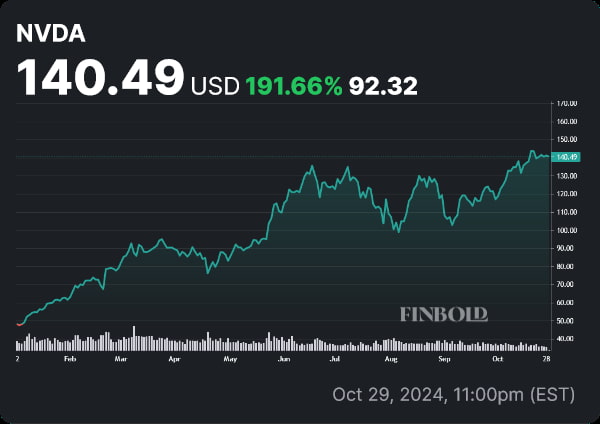As a notable frontrunner in the semiconductor industry, Nvidia (NASDAQ: NVDA) has managed to deliver outsized returns — owing chiefly to the company’s key position in the ongoing AI boom.
On a year-to-date (YTD) basis, NVDA stock is the second-best performer — currently only surpassed by Vistra Corp (NYSE: VST), an energy company that has rallied by 234.46% since January.
In the same timeframe, NVDA shares have seen a 191.66% price increase — at press time, the stock is trading at $140.49.

VST is in a stable, mature industry — and while it might be buoyed by AI’s significant demand for electricity, NVDA operates on the cutting edge, and seems set to secure large amounts of recurring revenue from growing industries.
Nvidia stock has rallied by 15.68% over the course of the last 30 days — although valuation concerns are present, it’s obvious that the business still has plenty of upward momentum.
Numerous analysts and equity researchers predict that the company will become the first holding in the S&P 500 with a $4 trillion market cap — or even the first $10 trillion market cap company. At a $4 trillion valuation, the stock would be worth approximately $163.29 — at $10 trillion, it would be roughly $408.24.
However, profits are not derived from market capitalization — at least not directly. The question on most retail investors’ minds is what Nvidia share price will be by the end of the decade.
Is NVDA stock’s growth sustainable?
At present, Wall Street is almost unanimously bullish on Nvidia — 93% of analysts who track the stock rate it a ‘Buy’. Unfortunately, risk and reward go hand in hand — and with the stock worth almost 12% of U.S. GDP, doubts surrounding valuation and the sustainability of NVDA’s growth are well-founded.
In the short term, barring any significant macroeconomic changes or geopolitical shifts, Nvidia will most likely hold a steady course — demand for the company’s newest line of Blackwell chips is ‘insane’, per CEO Jensen Huang, even accounting for minor design flaws.
The average price target for the stock set by Wall Street analysts is $153.86, which represents a humble 9.5% upside compared to current prices — although the upper end of estimates sees NVDA share price reaching as high as $200, which would equate to a 42.35% rise.
Though the company will almost definitely retain the lion’s share of the market, rivals like Advanced Micro Devices (NASDAQ: AMD) could very well become more competitive in coming years — reducing the justified premium backers are currently paying for the stock.
The key concern, on the whole, is whether the hype surrounding AI will pan out — full self-driving (FSD), robotics, generative AI, and large language models are still maturing fields. If a solid base of revenue is not established in those industries, institutional investors will find it hard to justify large capital expenditures for AI — most of which currently end up in Nvidia’s pockets.
This question will take some time to play out — as Alphabet (NASDAQ: GOOGL) CEO Sundar Pichai eloquently put it: ‘The risk of underinvesting is dramatically greater than the risk of overinvesting’ — at least for now.
Predicting Nvidia’s stock price in 2030 would be guesswork
As unsatisfying as this conclusion might be, it is the only reasonable one — predicting what the price of a stock will be in more than half a decade is speculative at best — particularly when discussing businesses at the forefront of new technologies.
By the end of the decade, worries about an AI bubble could materialize — on the other hand, so too could the beginning of widespread automation that radically transforms dozens of key industries.
While interesting, these far-reaching lines of reasoning aren’t of much use to investors — whereas the current state of affairs, as seen through metrics and short-term projections, can provide utility.
At the time of publication, Nvidia stock is trading at an attractive forward price-to-earnings (P/E) ratio of 24 — if your own judgment and research support the case that there is growth ahead, NVDA could be a valuable part of a portfolio — provided that you practice proper diversification and risk management.
Featured Image:
Michael Vi, Santa Clara, California, USA — December 1, 2021. Digital Image. Shutterstock.









